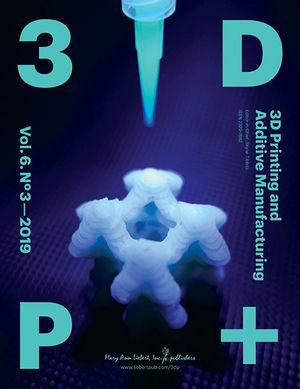
Three-dimensional (3D) printing of biomaterials has the potential to become an ecologically advantageous alternative compared with conventional manufacturing based on oil-derived polymer materials. In this study, a novel 3D printing technology is applied that combines ultraviolet (UV) curing with paste extrusion. This hybrid manufacturing technique enables the fabrication of complex geometries from high filler-ratio pastes. The developed biocomposite aims for suitable mechanical properties in terms of tensile and compressive strength. It is composed of acrylic acid, cellulose acetate, α-cellulose, and fumed silica with a cellulose ratio of more than 25 vol-%. The material is extruded with an in-house-developed 3D printer equipped with a 12 W UV light curing source, which enables concurrent curing and extrusion. Two different UV-curing strategies were tested: postcuring without concurrent curing and postcuring with concurrent curing. The total UV-curing duration was kept constant with all samples. Tensile testing in accordance with ASTM standard D638-14 Type 4, compression testing according to ASTM D695-15, and overhang tests were conducted. As a result, samples without notable shrinkage, suitable tensile strength (up to 17.72 MPa), competitive compression testing parameters (up to 19.73 MPa), and an enhanced overhang angle (increase of more than 25°) were produced, leading to new applications and more freedom in design due to higher possible unsupported overhangs when using UV-curing during the print. Overall, constant UV light radiation during the print leads to improved mechanical properties due to the possibility of bypassing the UV-penetration depth constraint. It should be considered when extruding photopolymer-based composites, especially for large and complex components with a low degree of translucency.
Keywords[edit | edit source]
3D printing; Mechanical testing; Natural fibre ; Natural fibre composites; Biopolymers; UV-assisted paste extrusion; biocomposite; 3D printing; mechanical properties; overhang testing; open-source platform
See also[edit | edit source]
- Ystruder: open source multifunction extruder with sensing and monitoring capabilities
- Mechanical Properties of Components Fabricated with Open-Source 3-D Printers Under Realistic Environmental Conditions
- Tensile Strength of Commercial Polymer Materials for Fused Filament Fabrication 3-D Printing
- Anisotropic mechanical property variance between ASTM D638-14 type I and type IV fused filament fabricated specimens
- The Effects of PLA Color on Material Properties of 3-D Printed Components
- Mechanical properties of 3-D printed truss-like lattice biopolymer non-stochastic structures for sandwich panels with natural fibre composite skins
- Wood Furniture Waste-Based Recycled 3-D Printing Filament
- 3-D printed magnetic soft magnetic helical coil actuators of iron oxide embedded polydimethylsiloxane
News[edit | edit source]
- Finland: Aalto University Researchers Experiment with Paste Extrusion & UV Curing of 3D Printed Biocomposites - 3D Print 64k
- Esperimento di ricercatori dell'Università di Aalto in Finlandia con estrusione di paste e polimerizzazione UV di biocompositi stampati in 3D- Stampare in 3D
- Forscher der Aalto Universität experimentieren mit Pastenextrusion und UV-Härtung von 3D-gedruckten Biokompositen 3D Ruck
- Finland: Aalto College Researchers Experiment with Paste Extrusion & UV Curing of 3D Printed Biocomposites 3D Printing Zoom
- Aalto University Researchers Experiment with Paste Extrusion & UV Curing of 3D Printed Biocomposites Gyges 3D





